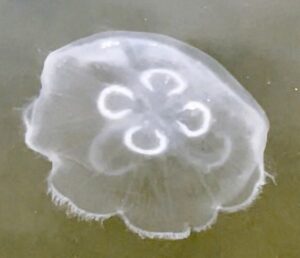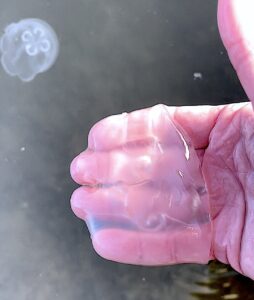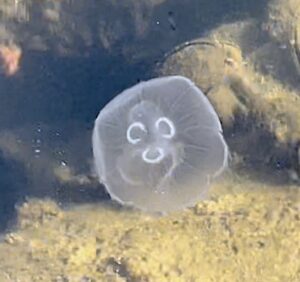Sue Lattanzio
Moon jellyfish (Aurelia aurita), often referred to as moon jellies, are very simple animals found in the phylum Cnidaria. We do not see them that frequently in BMK although you may see them at beaches in all oceans of the world except the artic. Moon Jellyfish are part of a natural balance in our ecosystem.
Here’s a few answers to some frequently asked questions:
- Are they dangerous? They are harmless to humans- they feed on zooplankton (larval stages of crabs, mussels shrimp, & protozoa). They are called “True Jellyfish” and their body looks like a transparent bell. (The cells they use to immobilize their food cannot penetrate human skin.) They do not need to be removed.
- What eats them? In the wild larger jellyfish, sometimes birds, larger fish, and turtles. In many parts of the world humans.
- What are they made of? They are mostly made of water and their bodies lack a digestive or circulatory system with no backbone, brain, blood, eyes, ears, or heart. They have 4 rings in the center of the bell called gonads for reproduction. If you hold them in your hand they feel like a blob of jello.
- Why are they in BMK ? They come to estuaries and places like BMK to breed. Reproduction happens in spring early summer and they become adults (Medusa) which we are now seeing, breeding through early summer and then they die off. The entire moon jelly lifecycle is 8-12 months. So while we see adults now in the lagoons we have been seeing other life cycle stages since last summer.
- Can we get rid of them? Yes this was asked…They can survive in a variety of habitats, although they may thrive at higher salinities (sea water above 32 ppt) and prefer water temperature above 60 degrees F, they can survive in the low salinities we have in BMK lagoons in winter (salinity below 10-20 ppt) and cooler temps (below 50 degrees F) Their environment affects the shape, size, and reproduction of moon jellyfish.
- Movement ? They are very graceful when they move forcing water in and out of their bells, and often seen in aquariums as they are easy to keep. They are not strong swimmers and are easily moved by currents and the wind so may accumulate where the wind blows them. So no nothing we can do and the are part of the food chain.
- Fun Fact: Moon Jellys are eaten in many Asian cultures and add a saltiness to dishes . Some say they taste like a slightly salty oyster. They can also be used to make ice cream.
-




